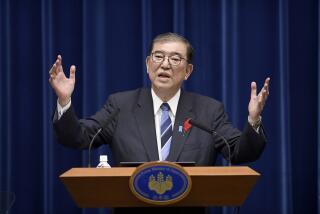The Political System in Japan
- Share via
I applaud former Secretary of State Henry A. Kissinger’s attempt (Opinion, Oct. 6) to recast the U.S.-Japan trade imbalance in terms of divergent cultural and political realities. However, after delving into Japanese factional politics, Kissinger throws up his hands in frustration and states that their political system is just too complex, too murky, too different for the United States to constructively deal with on trade issues. He reinforces this by suggesting that the United States specify “an overall total (of goods) that Japan will not exceed” and then compel Japan to stay within the figure by its own internal processes.
Japan is a nation with elections, interest groups, multiple parties, and legislatures like most other democracies. It can be lobbied and brought into constructive negotiation--but U.S. leaders need to learn what buttons to push. Now that Japan controls the second largest economy in the world, the United States better learn how to play Japan’s political game and not avoid interacting with their system, as Kissinger suggests.
Since the time of Japan’s Meiji Restoration in 1868, the bureaucrats have commanded the legislative process with more mastery than any other political group. Even after World War II, the occupation forces left the giant ministries relatively unscathed when nearly every other sector of their society was entirely reshaped. Eight out of Japan’s last 11 prime ministers began their careers as bureaucrats. Need I say more to explain why the “Ron-Yasu” meetings provide so little in the way of concrete trade results. We need President Reagan to meet with some administrative vice ministers who really control Japan’s legislative process.
The bottom line is that we shouldn’t run away from Japan’s political system; we should try to understand it. To influence their trade behavior, we need to begin not with “Yasu” but with the bureaucrats.
STEVEN C. CLEMONS
Los Angeles
More to Read
Get the L.A. Times Politics newsletter
Deeply reported insights into legislation, politics and policy from Sacramento, Washington and beyond. In your inbox twice per week.
You may occasionally receive promotional content from the Los Angeles Times.










